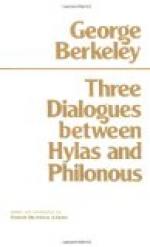HYL. I own myself entirely satisfied, that they are all equally apparent, and that there is no such thing as colour really inhering in external bodies, but that it is altogether in the light. And what confirms me in this opinion is, that in proportion to the light colours are still more or less vivid; and if there be no light, then are there no colours perceived. Besides, allowing there are colours on external objects, yet, how is it possible for us to perceive them? For no external body affects the mind, unless it acts first on our organs of sense. But the only action of bodies is motion; and motion cannot be communicated otherwise than by impulse. A distant object therefore cannot act on the eye; nor consequently make itself or its properties perceivable to the soul. Whence it plainly follows that it is immediately some contiguous substance, which, operating on the eye, occasions a perception of colours: and such is light.
Phil. Howl is light then a substance?
HYL. . I tell you, Philonous, external light is nothing but a thin fluid substance, whose minute particles being agitated with a brisk motion, and in various manners reflected from the different surfaces of outward objects to the eyes, communicate different motions to the optic nerves; which, being propagated to the brain, cause therein various impressions; and these are attended with the sensations of red, blue, yellow, &c.
Phil. It seems then the light doth no more than shake the optic nerves.
HYL. Nothing else.
Phil. And consequent to each particular motion of the nerves, the mind is affected with a sensation, which is some particular colour.
HYL. Right.
Phil. And these sensations have no existence without the mind.
HYL. They have not.
Phil. How then do you affirm that colours
are in the light; since by
light you understand a corporeal substance external
to the mind?




